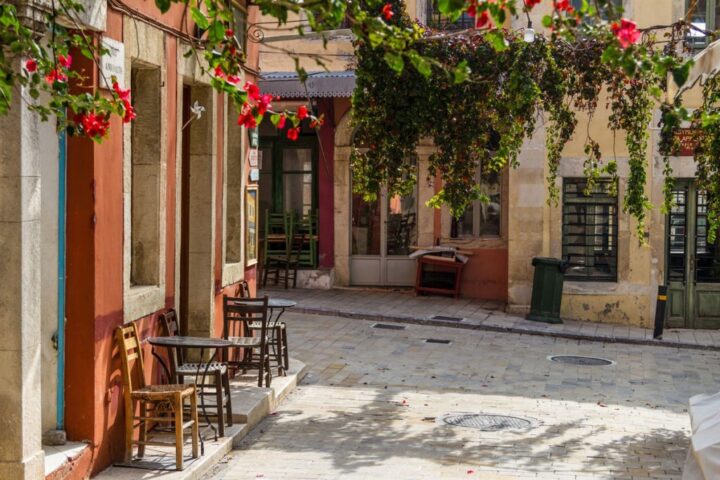Archanes or Epano Archanes is a picturesque small town, built at an altitude of 380 meters in the middle of a basin that it is crossed by Kaeratos stream, dividing it into two parts. It is located at the northeastern tip of the valley formed by Mount Yuchta, which has an altitude of 811 m. Archanes is 14 kilometers away from the city of Heraklion and only 7 kilometers from the Palace of Knossos. The colorful village has been prized by the European Union as model for residential development.
The main hamlet is today called Epano Archanes and stands separate from the quarter of Kato Archanes, which is one km to the north. Archanes has preserved its ancient Greek name, which can be found on a 5th century B.C. inscription. It is an alliance treaty between Knossos and Tylissos, and one of the provisions mentioned, “Archos will have the sanctuary in Acharna”. Archos was a local hero worshipped in Archanes. Archaeological testimony confirms the village’s inhabitation in prehistoric times and throughout history.
The valley and the whole area of Archanes is mostly a vast vineyard, producing the famous sultana grapes. The main products of Archanes are raisins – sultana, excellent quality wine from various varieties (local: kotsifali, mandilari, liatiko, vilana and other newly introduced) and also excellent quality olive oil. Also, aromatic plants are cultivated: dittany, thyme, sage.
History
When the Ottomans, after 22 years’ siege, managed to conquer the Venetian Chandax (Heraklion) in 1669, they gave the city as a gift to A. Baroci, the person who had betrayed it. Archanes became the stronghold of the rebels/guerrilla fighters. In the times of the Cretan State, the city flourished: wine, raisins and olive oil were exported and brought wealth to the city.
The well-to-do Archanians, wanting to express their love and desire to unite with Greece, built houses in the neoclassical style. Their mansion facades adopted an architectural trend imported from liberated Greece. This is how a unique hamlet of architectural interest was created, which has been preserved in its entirety.
Extensive pedestrianisation, picturesque cobblestone lanes, lamp posts and beautifully restored mansions give visitors to Archanes the opportunity to travel back in time. Christian churches decorated with murals coexist with fountains and wonderful buildings from the Ottoman era, the best one among them being Mustafa Naili Pasha’s residence, with fountains and gardens. On the north side of the valley is the quaint gorge named Paradeisi (small Paradise), which the Ottomans called Akarsular Dag (Mountain of the Running Waters). Within the same gorge, at Pelekita location, there is a water spring; in 1628, Fransesco Morosini channelled its waters to supply Heraklion. The spring is dry today because of water drilling projects in the area.
The town of Archanes was an important revolutionary centre of Eastern Crete during the 1897 Revolution. It was here that, as of February 1897, the Defense Committee of Archanes undertook the responsibility of coordinating military action in the broader region and Eastern Crete in general and faced major attacks by pro-Ottoman Cretans and the regular Ottoman army with remarkable bravery. In essence, the military part of the Cretan Question was decided in the region of Heraklion, centred round the town of Archanes, since the local geology makes it a natural fort, ideal, as proven later, to become the base of guerrilla fighters. Indeed, the celebration of the 15th of March in 1897 (Commemorating the onset of the Greek Liberation War against the Ottomans) was grand, in this, first, and only, liberated part of Crete, i.e. Archanes, with no presence of Ottoman Occupation troops.
The location of Archanes and the bravery and spirit of its inhabitants were the main factors for the active participation of the village in war events of the 20th century. During the Battle of Crete (May 1941 – WWII) the Command Centre of the Greek Forces was established in Archanes, where a rudimentary military hospital was also established. In the first year of the Nazi Occupation, the first Intelligence task force on Crete was organised in Archanes, offering great services to the Resistance. The presence of the Occupation Forces was particularly strong in Archanes, since it was the seat of the Nazi Military Division.



 Deutsch
Deutsch French
French Russian
Russian English
English




